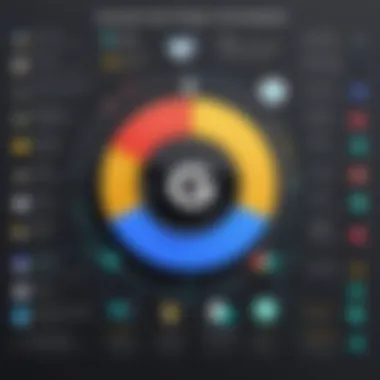Integrating Google and Expensify: Benefits and Insights


Intro
The integration of Google and Expensify symbolizes a strategic alignment in the tech landscape, specifically addressing the complexities of expense management. Both platforms stand as leaders in their respective domains: Google, with its extensive suite of productivity tools, and Expensify, recognized for its sophisticated expense tracking capabilities. As organizations and individuals navigate the challenges of finance management in an increasingly digital world, understanding this integration becomes critical.
In the ensuing sections, we will analyze the nature of their collaboration, exploring the functionalities they offer together. This goes beyond mere convenience; it taps into the potential for enhanced productivity, streamlined processes, and improved user experiences. The relevance of this discussion is amplified, considering the shift towards remote work and digital finance solutions.
By investigating various features, implementation methods, and user experiences, readers will gain insights tailored specifically for those who are not only tech-savvy but also decision-makers within their organizations. Our aim is to delineate the benefits and drawbacks of this integration, equipping our audience to make informed software choices moving forward.
Prelims to Google and Expensify
In an era of digital transformation, the integration of tools for finance and productivity is crucial for individuals and businesses. Google and Expensify provide distinct functionalities that, when combined, create a robust solution for managing expenses effectively. The importance of understanding their integration lies in its ability to enhance operational efficiency and improve financial tracking. As organizations navigate complex financial landscapes, the synergy between these two platforms becomes increasingly valuable.
Overview of Google Services
Google offers a suite of services designed to streamline communication and facilitate productivity. Services like Google Drive, Google Sheets, and Google Calendar provide users with tools that foster collaboration and enhance data management. Google Drive allows users to store and share files securely, while Google Sheets offers spreadsheet capabilities that aid in budget planning. Google Calendar is essential for scheduling tasks and deadlines. This ecosystem supports users in organizing various aspects of their personal and professional life, aligning with the need for efficient expense management.
Additionally, the integration of tools like Google Workspace enables teams to work in real-time on shared documents. This collaboration is vital for businesses that require transparency in financial reporting and expense approval processes. The versatility of Google services enhances their attraction and offers potential synergy with Expensify, making them a powerful combination for expense tracking and management.
Overview of Expensify
Expensify specializes in expense management solutions, targeting both individual users and businesses. Its key features include receipt scanning, expense reporting, and integrations with various accounting systems. Users can easily photograph receipts and upload them, converting the data into organized expenditures. This automation minimizes errors and saves time, making the process more efficient.
Furthermore, Expensify offers users the ability to categorize expenses according to different criteria, such as project or client. This feature is especially beneficial for freelancers and companies that aim to manage project budgets effectively. Expensify can also generate reports that provide insights into spending patterns, which aids in making informed financial decisions.
By understanding the capabilities of both Google and Expensify, users can appreciate the benefits that this integration can bring. In the following sections, we will explore how these systems complement each other, enhancing overall productivity and accuracy in expense management.
Key Features of Google Services
Google offers a wide array of services that are instrumental in enhancing productivity and efficiency for both individuals and organizations. Understanding these key features is essential for comprehending how Google can be effectively integrated with Expensify. This section explores two critical areas: productivity tools and cloud storage solutions.
Productivity Tools
Google's productivity tools, such as Google Workspace, provide a robust platform for collaboration and workflow management. These tools include Google Docs, Sheets, and Slides, which allow users to create, edit, and share documents seamlessly online. The real-time collaboration feature enables multiple users to work on a document simultaneously, which is crucial for teams that need to coordinate effectively.
One significant benefit of using these tools is the ease of accessibility. Because they are cloud-based, users can access their work from any device with an internet connection. This flexibility supports remote work and allows for a more agile response to changes in project demands. Additionally, with built-in commenting and editing tools, communication among team members becomes simpler, which streamlines the overall workflow.
Moreover, Google's productivity tools integrate well with other services offered by Google. For example, Google Calendar allows scheduling meetings directly from Google Docs, enhancing efficiency.
Cloud Storage Solutions
Google Drive is another key component of Google's service offerings. It provides a reliable cloud storage solution that allows users to store and share files securely. The storage capacity is ample for both personal and professional needs, with various plans available to accommodate increasing storage requirements.
A paramount consideration for users is the accessibility of information. Google Drive enables users to access their files from any device, making it convenient for people on the go. Additionally, it ensures that important documents are backed up in the cloud, reducing the risk of data loss.
The integration of Google Drive with Expensify can significantly enhance expense management. Users can store receipts and other related documents directly in Google Drive and link them to their Expensify account, providing a centralized system for managing financial data.
"Integrating Google Drive with expense management tools streamlines data accessibility and backup, reducing manual errors in financial reporting."
In summary, the productivity tools and cloud storage solutions offered by Google play a fundamental role in creating an efficient environment for expense management when integrated with Expensify. These features enhance collaboration, ensure data security, and support better organization. Understanding these functions provides a solid foundation for comprehending the integration of Google and Expensify.
Key Features of Expensify


Understanding the key features of Expensify is essential as it delineates how this platform effectively supports expense management. This section lays out the critical functionalities that set Expensify apart in the realm of financial software. Each feature contributes to a seamless user experience while ensuring that businesses maintain optimal control over their finances.
Expense Tracking Capabilities
One of the standout features of Expensify is its robust expense tracking capabilities. Users can easily capture receipts through their mobile devices by taking photos, which the application then processes to extract relevant data. This function eliminates the need for manual entry, thus reducing errors. Users have the flexibility to categorize expenses, making it easier to understand spending patterns.
Moreover, Expensify allows for real-time tracking of expenses. This integration means that team members can submit expenses as they incur them, preventing any backlog of submissions. This streamlining of the expense reporting process significantly reduces the time financial teams spend on reconciling reports.
"Real-time expense tracking equips businesses with the ability to make financial decisions based on current data, improving both reaction times and strategic planning."
The ability to generate detailed reports also adds value. Users can compile expenses for specific projects or time frames, creating a clear overview of financial health. These reports can assist not only in budget management but also in strategic planning.
Integration with Financial Systems
The integration capabilities of Expensify with various financial systems further enhance its usefulness. Expensify can seamlessly connect with popular accounting software like QuickBooks, Xero, and NetSuite. This integration allows for a smoother flow of information between platforms, which minimizes the need for dual entry and reduces reconciliation headaches.
This feature is particularly advantageous for businesses that require accurate reporting and audit trails. By connecting with established systems, it provides a comprehensive view of financial data. Users can automatically sync their expense reports with their accounting software, ensuring that the information is always up-to-date.
A well-integrated system ensures that every transaction is recorded and categorized appropriately. This minimizes discrepancies and aids in maintaining compliance with financial regulations. Furthermore, this integration enhances data analytics, allowing businesses to draw insights from historical trends and forecasts.
The Benefits of Integrating Google with Expensify
The integration of Google with Expensify brings several advantages that can significantly transform the way individuals and businesses manage expenses. These benefits extend across various aspects, enhancing not only productivity but also collaboration and security. Understanding these elements is vital for making informed decisions regarding software solutions in financial management.
Streamlining Workflow
One of the most immediate effects of integrating Google and Expensify is the streamlining of workflow. When users adopt both tools, they find that sending invoices, tracking receipts, and managing budgets becomes a more coherent process. With Google Drive, users can easily store documents and receipts related to expenses, while Expensify handles the expense reporting aspects. The two platforms can ensure that users have a unified approach to their finances.
- Automated Data Entry: Integration enables automatic syncing of data, reducing manual entry and potential errors.
- Centralized Information: All expense-related documents are accessible in one place, eliminating confusion and improving organization.
- Time Efficiency: Simplified processes save time, allowing users to focus on analysis rather than administrative tasks.
Enhancing Collaboration
Collaboration is crucial, especially in team settings. The integration fosters better communication and interaction among team members. Google’s tools allow instant sharing and collaboration on documents, which can be paired with Expensify’s functionalities for managing shared expenses. Team members can view updates in real-time, which promotes transparency and accountability.
- Shared Access: Multiple users can access and manage expenses collectively, making it easier for teams to work together.
- Comments and Feedback: Team members can leave comments directly on documents, facilitating real-time feedback.
- Simplified Reporting: Collaborative features lead to streamlined reporting processes, enhancing overall efficiency.
Improved Data Security
Data security is a growing concern in today's digital landscape. Integrating Google with Expensify offers enhanced protective measures for sensitive financial information. Both platforms prioritize user privacy and data safety, ensuring that information is secure during storage and transmission.
- End-to-end Encryption: Sensitive data is encrypted, protecting it from unauthorized access.
- User-Access Controls: Admins can set permission levels in both platforms, ensuring that only authorized personnel have access to specific information.
- Regular Security Updates: Both Google and Expensify continuously improve their security protocols to address emerging threats.
"Integrating Google with Expensify not only streamlines workflows but also enhances collaboration and safety, empowering users to manage expenses effectively."
In summary, the benefits of integrating Google with Expensify are substantial. By streamlining workflows, enhancing collaboration, and improving data security, users can expect a more efficient approach to expense management. Understanding these benefits helps in making the most out of both platforms, leading to informed choices in expense handling.
User Experience: Feedback and Case Studies
The integration of Google services with Expensify offers a unique opportunity to examine user experiences through individual feedback and structured case studies. Understanding user experiences is critical as it provides insights into how these platforms work together in real-world scenarios. This section explores individual user testimonials alongside comprehensive business case studies, each offering a different perspective regarding efficiency, trouble areas, and overall satisfaction. This analysis not only shines a light on practical usage but also identifies best practices and potential pitfalls in the integration process.
Individual User Experiences


Feedback from individual users often highlights personal and immediate benefits gained from the integration of Google services with Expensify. Many users report that features such as automatic transaction syncing and real-time expense tracking dramatically streamline their processes. In one user case, a freelance graphic designer shared that utilizing Google Drive alongside Expensify enabled seamless receipt uploads. This eliminated the tedious task of manually logging expenses, allowing for a more focused and productive work routine.
Other individuals emphasize the ease of use, especially for those already familiar with the Google ecosystem. The intuitive interface of both platforms allows users to adapt quickly, effectively reducing the learning curve. Users frequently mention how features, like Google Sheets integration, allow for customized reporting. This helps them visualize their spending habits, providing necessary insights for financial decisions.
However, feedback is not entirely positive. Some users have experienced difficulties during the setup phase, particularly regarding linking accounts and data migration. Such hurdles can lead to frustration. Regularly noted has been the need for clearer documentation and troubleshooting resources from Expensify to ease this initial transition. Gathering this feedback contributes to understanding user needs better and offers directions for future improvements.
Business Case Studies
Examining case studies from businesses illustrates the integration's impact on a larger scale, showcasing how various environments benefit from streamlined financial processes. For instance, a mid-sized marketing agency reported a significant decrease in expense report processing times after integrating Google with Expensify. Previously, employees struggled with lengthy manual entry and discrepancies in reported expenses. Following the integration, the agency processed expense reports 40% faster, which led to improved employee satisfaction.
In another example, a non-profit organization implemented the integration to better manage donor-related expenses. This case highlights that regular reporting through Google Sheets and automated expense categorizations simplified compliance. The integration allowed for transparent reporting to stakeholders, which is crucial for maintaining trust in financial dealings.
These case studies underline that businesses often experience better financial oversight and increased accountability. However, there are costs associated with premium Expensify features which can be a barrier for smaller firms. Evaluating ROI becomes a necessary exercise for businesses considering integration.
"Integrating Google with Expensify not only streamlined our expense reports but provided us with data-driven insights to optimize future budgets." - Excerpt from a business case study.
Ultimately, analyzing both individual experiences and business case studies equips potential users with a comprehensive understanding of what to expect from the integration. The lessons learned and formal feedback gathered reveal both promising benefits and areas for consideration in utilizing these powerful tools together.
Implementation Process
The implementation process for integrating Google and Expensify is crucial. It serves as the bridge that connects the functionalities of both platforms, allowing users to harness their combined power. Proper integration can drastically improve expense management efficiency, ensuring that data flows seamlessly from one system to another. Effective implementation can reduce manual tasks and errors, ultimately saving time and resources.
Setting Up the Integration
Setting up the integration of Google with Expensify involves several systematic steps. First, ensure that you have active accounts on both platforms. Then, navigate to the integration settings on Expensify. Users can find this under the settings menu. Here, select Google as the chosen integration option.
Next, you will need to authenticate the linking of accounts. This usually involves logging into your Google account and granting Expensify access to necessary data. Make sure to review the permissions. It is important to check what information Expensify can access and how it will use that data.
Upon successful setup, both platforms can sync. Users can automatically import data from Google Drive or generate reports in Expensify using Google Sheets. This functionality opens various avenues for data management, providing a more integrated experience. For detailed guidance, you can refer to the official documentation on Expensify's website
Best Practices for Use
After setting up the integration, following best practices will enhance user experience. First, frequently review and update permissions between the two applications. Changes in team structure or projects can affect access needs. Furthermore, a consistent review helps maintain security over sensitive financial data.
Utilizing templates in Google Sheets is another effective practice. Users can create expense reporting templates that streamline data entry. Regular updates of templates keep them relevant as workflow demands change.
Lastly, training team members on both platforms ensures that everyone understands how to leverage the integration. This can lead to better collaboration and more efficient use of the tools.
Having a proactive approach to managing the integration can avoid potential issues down the line. The efficiency gained from understanding and properly using the integrated systems can reflect positively on overall productivity and financial accuracy.
"Successful integration of technology tools relies not just on the setup but also on how effectively they are employed in daily operations."
Potential Limitations and Considerations
Understanding the potential limitations and considerations of integrating Google services with Expensify is crucial for businesses and individuals contemplating this merger. The integration, while beneficial in many aspects, is not without its challenges. Addressing these limitations upfront helps in creating realistic expectations.
Challenges in Integration
Integrating Google with Expensify can pose several challenges. First, there may be technical issues during the setup phase. Different systems often have compatibility issues. Users might face problems syncing data between platforms. This can lead to incomplete or inconsistent expense reports. It can be necessary to invest time in troubleshooting these integration challenges.
Furthermore, training staff to effectively use the integrated system can take time and resources. If employees are not familiar with either platform, the learning curve might affect productivity temporarily. The lack of intuitive design in both interfaces can add to the frustration. This is particularly true if users are not tech-savvy.


Lastly, data privacy and security concerns are also integral to consider. Sensitive financial information is shared between two platforms. As a result, understanding how each platform protects user data is essential. Users must navigate the privacy policies of both services, ensuring that the integration complies with their organization’s data security protocols.
Cost Implications
When integrating Google services with Expensify, understanding the cost implications is important. While both platforms offer essential features, there are financial commitments to consider. Subscriptions for both Google Workspace and Expensify can accumulate, especially for larger teams. These subscriptions usually include enhanced features that are necessary for effective use.
Additionally, businesses should account for the possible need for IT support. If technical challenges arise during the setup of the integration, hiring a consultant may incur further costs. This is particularly vital for companies without a dedicated IT team. Investing in training sessions for employees also adds to the overhead, making budgeting critical.
Moreover, hidden costs might stem from upgrading existing software or additional tools. For example, if a company needs better cloud storage, it may require an upgrade to a more expensive Google Drive plan.
Having a clear understanding of all potential costs upfront allows organizations to make informed decisions and avoid unwelcome financial surprises.
Overall, it remains essential to conduct a thorough cost-benefit analysis. Businesses must weigh the anticipated advantages of integration against these potential limitations to determine if the synergy is worthwhile.
Future of Google and Expensify Integration
The integration of Google and Expensify represents a significant advancement in expense management solutions. As technology evolves, the synergy between these platforms is expected to deepen. Understanding the future of this integration is crucial for users and organizations seeking to optimize operations and improve efficiency.
Technological Advancements
Technological advancements are fundamentally reshaping the landscape of software solutions. Google, with its robust suite of productivity tools and cloud capabilities, continues to innovate. Expensify also has a strong focus on enhancing its core functionalities.
Artificial Intelligence (AI) and Machine Learning (ML) are at the forefront of these advancements. For instance, Google is rolling out enhanced AI features that could assist in automating various tasks. Users can expect features like smarter data extraction from receipts and automated expense categorization. This will reduce the time spent on manual entries.
Additionally, the introduction of APIs and integrations will allow seamless interactions between Google services and Expensify. Businesses can develop custom workflows that are tailored to their specific needs, streamlining processes significantly. This could mean real-time updates and better financial insights that drive decision-making.
Other technologies like blockchain may also play a role in improving transaction verification and transparency within Expensify. Such features can bolster the confidence of businesses in their expense processes by providing secure and tamper-proof records.
Shifting User Preferences
User preferences are a key driver in how software evolves and integrates. With remote work becoming more common, there is a heightened focus on collaborative tools. Users now seek solutions that can work seamlessly together. Google’s applications like Google Docs and Sheets need to integrate efficiently with Expensify for topics such as team expenses and reporting.
Moreover, simplicity and user-friendliness are paramount. Users increasingly value applications that offer intuitive interfaces and a minimal learning curve. As such, Expensify will need to focus on enhancing its user experience while ensuring it complements Google’s existing framework. Features that provide instant insights and easy navigation will likely attract more users looking for effective expense management.
Mobile application development is also essential. As users rely more on smartphones for managing personal and professional tasks, optimizing features for mobile use is critical. Google and Expensify will likely continue to enhance their mobile apps to cater to this demand, enabling users to track expenses on-the-go.
The future holds potential for powerful integrations that enhance user experience and streamline operational efficiency.
End
The conclusion of this article encapsulates the significance of integrating Google services with Expensify. As we have explored, this integration provides various advantages, such as enhanced workflow efficiency and improved collaboration. By understanding the capabilities of both platforms, users can leverage these tools for superior expense management and financial tracking.
Summarizing Key Insights
In discussing the integration between Google and Expensify, several core insights emerge:
- Streamlined processes: The combination reduces manual effort in data entry and accuracy errors.
- Collaboration enhancements: Teams can share data seamlessly, improving communication and accountability.
- Data security: Both platforms adhere to stringent security protocols, reducing risks associated with sensitive financial information.
- Flexibility: Users can customize workflows based on specific needs, allowing for tailored solutions.
Each of these insights highlights the compelling reasons for considering this integration in both individual and organizational contexts. Invariably, adopting this technology can lead to both time savings and cost reductions.
Final Thoughts on Integration
The integration of Google services with Expensify represents a pivotal advancement in managing expenses and finances more effectively. As businesses increasingly rely on digital tools for operation, the synergy between these platforms cannot be overlooked.
While challenges exist, such as potential issues with compatibility and cost, the overall advantages generally outweigh these concerns. Organizations are encouraged to evaluate their specific needs and consider how this integration aligns with their operational goals.
Adopting this integrated approach is not merely about keeping pace with technology; it is about harnessing information strategically. The future of financial management lies in such integrations, promising greater efficiency and insight into financial practices.







